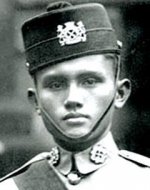should the fall of singapore really came about, i will definitely expect to see the valiant First Malay Regiment -
Between 13 and 14 February 1942, Singapore witnessed one of its fiercest battles ever known in her history. Amongst those who fought valiantly in that Battle for Pasir Panjang and lost their lives was a 27 year-old infantry officer, Lieutenant Adnan bin Saidi. Adnan Saidi (pic 2) and his contingent from the 1st and 2nd Battalion of the Malay Regiment fought fearlessly to defend Pasir Panjang Ridge. The ferocious fight put up by the Malay Regiment came for special mention in Lieutenant General A.E. Percival’s Despatch on the Operations of Malaya Command from 8th December 1941 to 15th February 1942.
Mentioned by Major General A.E. Percival (GOC Malaya 1941/42), from foreword to 'The Malay Regiment of 1933-1947' which was published in 1947 by Mubin C. Sheppard;- "When the war broke out in the Far East(Southeast Asia), the regiment was in process of expansion. In consequence, like many other units of our Imperial Force, (it) was not fully prepared for the ordeal which it was to face. Nevertheless, these young and untried soldiers acquitted themselves in the way which bore comparision with the very best troops in Malaya. In particular, by their stubborn defence of the Pasir Panjang Ridge at the height of the Battle of Singapore, they set an example of steadfastness and endurance which will become a great tradition in the Regiment and an inspiration for the future generations."
At this historic site, Singapore’s last stand for defence was made in an epic 48-hours battle, culminating in the only (recorded) fiery hand-to-hand combat against the Japanese Army.
"After two hours of heavy shelling and mortaring, the Japanese attacked the Malay Regiment which was holding Pasir Panjang Ridge. The latter fought magnificently, but suffered heavy casualties, and by afternoon the enemy had reached the Gap (Pasir Panjang Ridge)…"
Australian troops fighting nearby looked on with horror at what happened next. “The Malays started to fight the Japanese on Reformatory Road,” said Lt. Penrod V. Dean of the 2/4th Machine Gun Battalion. “They had dug slit trenches but they didn't have a lot of weapons. They started fighting the Japanese just with rifles virtually. And when the Japanese broke through them, the Malays took to them with bayonets, they put bayonets on the rifles and with a bayonet charge they drove the Japanese back across Reformatory Road. They were very brave people. They fought very hard, but for every Malay soldier there was about 10 or 12 Japanese soldiers. So it was inevitable what was going to happen.”
The next day, the British surrendered. The Japanese separated officers and men among their prisoners, sending the Malay rank and file to join Indian enlisted men in an enclosure at Farrer Park. Rix and all the battalion’s British officers had died fighting.
And then there was the Malay lieutenant.
Grievously wounded, Adnan was instantly recognized as the short berserker who had personally killed dozens of Japanese. His captors beat him savagely, then slowly killed him with bayonet thrusts.
Five other Malay officers were captured by the Japanese. “My husband, Ibrahim Sidek, and his friends were told by the Japanese to take off their Malay Regiment uniforms and accept release,” Sharifah Khadijah Hamid recounted years later. “They refused. They didn't even want to remove their badges of rank. A week later, the Japanese executed them. My children were still very young, too young to know their father. His body was never found. We cannot even remember him with a grave.”
Rest in peace dear defenders of singapore.
Your sacrifice will not be ever forgotten.




